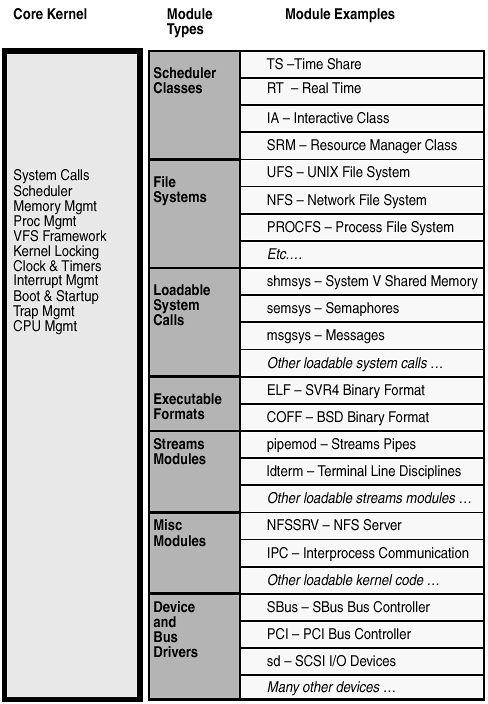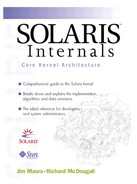1.3. Kernel Overview
The Solaris kernel is the core of Solaris. It manages the system hardware resources and provides an execution environment for user programs. The Solaris kernel supports an environment in which multiple programs can execute simultaneously. The primary functions of the kernel can be divided into two major categories: managing the hardware by allocating its resources among the programs running on it; and supplying a set of system services for those programs to use.
The Solaris kernel, like that of other operating systems implementations, provides a virtual machine environment that shields programs from the underlying hardware and allows multiple programs to execute concurrently on the hardware platform. Each program has its own virtual machine environment, with an execution context and state.
The basic unit that provides a program's environment is known as a process; it contains a virtual memory environment that is insulated from other processes on the system. Each Solaris process can have one or more threads of execution that share the virtual memory environment of the process, and each thread in effect executes concurrently within the process's environment. The Solaris kernel scheduler manages the execution of these threads (as opposed to management by scheduling processes) by transparently time-slicing them onto one or more processors. The threads of execution start and stop executing as they are moved on and off the processors, but the user program is unaware of this. Each time a thread is moved off a processor, its complete execution environment (program counter, stack pointers, registers, etc.) is saved, so when it is later rescheduled onto a processor, its environment can be restored and execution can resume. Processes and scheduling are covered in detail in Part 3 of this book.
The kernel provides mechanisms to access operating system services, such as file I/O, networking, process and thread creation and termination, process control and signaling, process memory management, and interprocess communication. A process accesses these kernel services through the use of system calls. System calls are programming interfaces through which the operating system is entered so that the kernel can perform work on behalf of the calling thread.
1.3.1. Solaris Kernel Architecture
The Solaris kernel is grouped into several key components and is implemented in a modular fashion. The key components of the Solaris kernel are described in the following list and illustrated in Figure 1.1.
Figure 1.1. Solaris Kernel Components

System Call Interface — The system call interface allows user processes to access kernel facilities. The system call layer consists of a common system call handler, which vectors system calls into the appropriate kernel modules.
Process Execution and Scheduling — Process management provides facilities for process creation, execution, management, and termination. The scheduler implements the functions that divide the machine's processor resources among threads on the system. The scheduler allows different scheduling classes to be loaded for different behavior and scheduling requirements.
Memory Management — The virtual memory system manages mapping of physical memory to user processes and the kernel. The Solaris memory management layer is divided into two layers: the common memory management functions and the hardware-specific components. The hardware-specific components are located in the hardware address translation (HAT) layer.
File Systems — Solaris implements a virtual file system framework, by which multiple types of file system can be configured into the Solaris kernel at the same time. Regular disk-based file systems, network file systems, and pseudo file systems are implemented in the file system layer.
I/O Bus and Device Management — The Solaris I/O framework implements bus nexus node drivers (bus-specific architectural dependencies, e.g., a PCI bus) and device drivers (a specific device on a bus, e.g., an Ethernet card) as a hierarchy of modules, reflecting the physical layout of the bus/device interconnect.
Kernel Facilities (Clocks, timers, etc.) — Central kernel facilities, including regular clock interrupts, system timers, synchronization primitives, and loadable module support.
Networking — TCP/IP protocol support and related facilities. The Solaris networking subsystem is implemented as streams-based device drivers and streams modules.
1.3.2. Modular Implementation
The Solaris kernel is implemented as a core set of operating system functions, with additional kernel subsystems and services linked in as dynamically loadable modules. This implementation is facilitated by a module loading and kernel runtime linker infrastructure, which allows kernel modules to be added to the operating system either during boot or on demand while the system is running.
The Solaris 7 module framework supports seven types of loadable kernel modules: scheduler classes, file systems, loadable system calls, loaders for executable file formats, streams modules, bus or device drivers, and miscellaneous modules. Figure 1.2 shows the facilities contained in the core kernel and the various types of kernel modules that implement the remainder of the Solaris kernel.
Figure 1.2. Core Kernel and Loadable Modules

